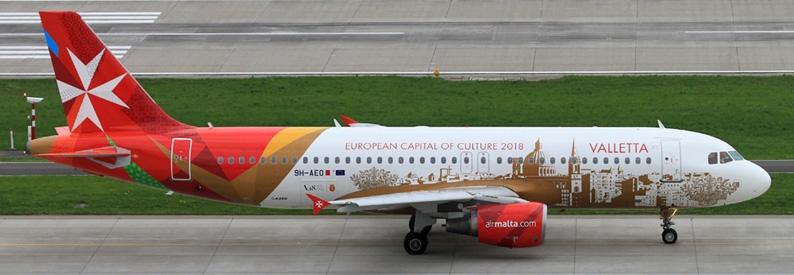Air Malta to cut half of its staff, reveals new fleet plans

Air Malta (KM, Malta Int’l) is to lay-off almost half of its workforce as part of the Maltese government’s plan to save EUR15 million euros (USD17 million) a year in a last-bid cost-saving effort to rescue the loss-making airline, according to Finance Minister Clyde Caruana.
Speaking at a news conference on January 14, he confirmed that more than 400 of the company’s 890 employees would be let go. Between 110 and 120 administrative staff would be transferred out of the company to other public sectors as part of a voluntary transfer scheme that would remain open until January 28, local media report.
In addition, Air Malta would close down its ground handling operation in the second quarter of 2022, leading to a further loss of 300 workers, who would be offered similar inter-governmental transfers down the line. The airline wants to conclude collective bargaining agreement discussions as soon as possible with various trade unions representing employees, following a meeting on Friday 14 ahead of the announcement.
Caruana confirmed the national airline was currently making a loss of EUR170,000 (USD193,000) a day, having racked up EUR258 million (USD294 million) in operational losses since 2005, reported Malta Independent newspaper.
In another cost-saving measure, the airline also revealed it had changed its plans to acquire two A321-200NX(XLR)s after abandoning its long-haul ambitions. Last year it successfully negotiated with Airbus (AIB, Toulouse Blagnac) to convert the acquisition of two XLR aircraft with three A320-200Ns instead. “Air Malta is currently seeking to refinance its new aircraft and their relative leases and has issued an international Sale and Lease Back RFP for this purpose. By Q1 2024 Air Malta’s entire fleet will consist of a single type aircraft – the A320neo,” an airline spokesperson confirmed to ch-aviation.
According to the ch-aviation fleets advanced module, Air Malta’s current fleet comprises three A320-200s and four A320-200Ns.
Malta has been negotiating with the European Commission (EC) since April 2021 for EUR290 million (USD332 million) in state aid for Air Malta as part of a five-year state aid financing plan to turn around the national carrier amid increasing calls from political parties for greater transparency in the government’s dealings with Brussels.
Caruana could not disclose how much funding the EC would approve but stressed these cost-saving measures were non-negotiable to save the airline. Whatever funding was granted would cover losses during COVID-19, whereas the airline had already faced significant challenges before the pandemic. He said Brussels had lost faith in Air Malta given a string of broken promises to turn the company around.
“Every time a plane flew to any destination, that flight resulted in a loss for the company. So, I could never pretend that the Commission would allow us to give a large sum of cash,” he said. Still, the amount would not affect the cost-saving decisions made public or if the airline would continue flying. “The Commission’s preferred option was to close the company and form a new one, but I told them I didn’t agree with this decision,” he disclosed.
Air Malta already received state aid in 2015. Under standard EU state aid rules, this meant a “one-time last-time” principle applied, allowing for state aid once every ten years – by 2026, Caruana explained.
Turning to planned cost-saving measures, Air Malta executive chairman David Curmi said the airline would explore establishing bases outside of Malta for flights that would not land on the Mediterranean island. The aim was to save on unsustainable unit costs. Cost comparisons between Air Malta, Ryanair, easyJet, and Aegean Airlines had shown that the Maltese’ carrier’s unit costs were 44% higher, mainly due to overstaffing and pricey ground handling. News reporters were told that Air Malta currently held only a 30% share of the local market, with Ryanair holding the lion’s share.
The airline could also save EUR3.9 million (USD4.4 million) annually by operating more charter and cargo flights, Curmi said.
The airline’s route network would be downsized further after already having halved the number of destinations from 40 to 20 for the 2022 summer.
